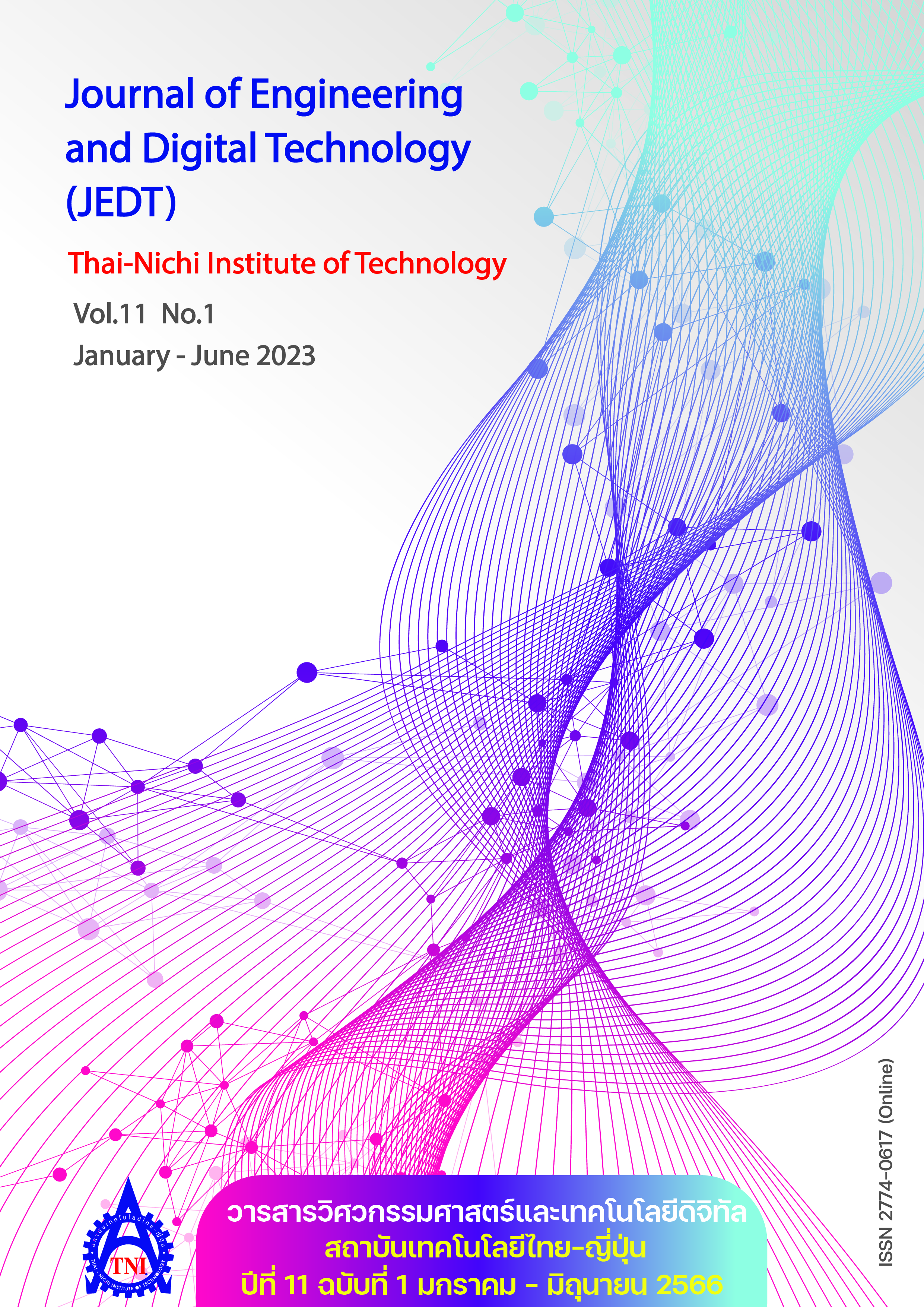Development of Mask Classification and Wearing Detection Program with Image Processing Technology
Main Article Content
Abstract
Development of mask classification and wearing detection program with image processing technology which is purpose to classify and detect wearing masks. There are three steps 1) data set preparation 2) model training and 3) mask classification and wearing. Our research collected datasets with 4 classes; class 1: non-wearing mask, class 2: surgical mask, class 3: cloth mask, and class 4: N95 mask. Our mask classification and wearing detection experiment, two algorithms which are YOLOv4 on Tensorflow and YOLOv5 on Pytorch are compared with 2,311 datasets. We found that the average of accuracy (mAP) of the YOLOv5 (0.9943) is better than the YOLOv4 (0.9057) while the YOLOv5 can classify the cloth mask with the maximum F1-score at 0.9995. Twelve persons are set in the real situation with webcam. The result shown that the YOLOv5 model can correctly detect the 11 persons (0.91%).
Article Details

This work is licensed under a Creative Commons Attribution-NonCommercial-NoDerivatives 4.0 International License.
Article Accepting Policy
The editorial board of Thai-Nichi Institute of Technology is pleased to receive articles from lecturers and experts in the fields of engineering and technology written in Thai or English. The academic work submitted for publication must not be published in any other publication before and must not be under consideration of other journal submissions. Therefore, those interested in participating in the dissemination of work and knowledge can submit their article to the editorial board for further submission to the screening committee to consider publishing in the journal. The articles that can be published include solely research articles. Interested persons can prepare their articles by reviewing recommendations for article authors.
Copyright infringement is solely the responsibility of the author(s) of the article. Articles that have been published must be screened and reviewed for quality from qualified experts approved by the editorial board.
The text that appears within each article published in this research journal is a personal opinion of each author, nothing related to Thai-Nichi Institute of Technology, and other faculty members in the institution in any way. Responsibilities and accuracy for the content of each article are owned by each author. If there is any mistake, each author will be responsible for his/her own article(s).
The editorial board reserves the right not to bring any content, views or comments of articles in the Journal of Thai-Nichi Institute of Technology to publish before receiving permission from the authorized author(s) in writing. The published work is the copyright of the Journal of Thai-Nichi Institute of Technology.
References
P. Intra, “Filtration efficiency of surgical masks, fabric masks and N95/KN95/FFP1/FFP2 masks available for use during the COVID-19 pandemic in Thailand,” (in Thai), Thai Sci. Technol. J., vol. 29, no. 5, pp. 904–918, 2021.
R. C. Gonzalez and R.E. Woods, Digital Image Processing, 3rd ed. Upper Saddle River, NJ, USA: Pearson Prentice Hall, 2008.
J. Wu, “Introduction to convolutional neural networks,” National Key Lab for Novel Software Technology, Nanjing University, Nanjing, China, Accessed: Jan. 20, 2022. [Online]. Available: https://cs.nju.edu.cn/wujx/paper/CNN.pdf
J. Redmon, S. Divvala, R. Girshick, and A. Farhadi, “You only look once: Unified, real-time object detection,” in Proc. IEEE Conf. Comput. Vision and Pattern Recognit. (CVPR), Las Vegas, NV, USA, 2016, pp. 779–788.
J. Redmon and A. Farhadi, “Yolov3: An incremental improvement,” arXivLabs: experimental projects with community collaborators, Apr. 8, 2018. Accessed: Jan. 20, 2022. [Online]. Available: https://arxiv.org/abs/1804.02767
A. Bochkovskiy, C.-Y. Wang, H.-Y. M. Liao, “Yolov4: Optimal speed and accuracy of object detection,” arXivLabs: experimental projects with community collaborators, Apr. 2020. Accessed: Jan. 20, 2022. [Online]. Available: https://arxiv.org/abs/2004.10934
YOLOv5: The friendliest AI architecture you'll ever use, Ultralytics Company, Aug. 2013. [Online]. Available: https://ultralytics.com/yolov5
H. Adusumalli, D. Kalyani, R. K. Sri, M. Pratapteja, and P. V. R. D. P. Rao, “Face Mask Detection Using OpenCV,” in Proc. 3rd Int. Conf. Intell. Commun. Technol. and Virtual Mobile Networks (ICICV), Tirunelveli, India, Feb. 2021, pp. 1304–1309.
S. Teboulbi, S. Messaoud, M. A. Hajjaji, and A. Mtibaa, “Real-Time implementation of AI-based face mask detection and social distancing measuring system for COVID-19 prevention,” Scientific Program., vol. 2021, Sep. 2021, Art. no. 8340779.
S. Sethi, M. Kathuria, and T. Kaushik, “Face mask detection using deep learning: An approach to reduce risk of Coronavirus spread,” J. Biomed Inform., vol. 120, Aug. 2021, Art. no. 103848.
H. Goyal, K. Sidana, C. Singh, A. Jain, and S. Jindal. “A real time face mask detection system using convolutional neural network,” Multimedia Tools Appl., vol. 81, no. 11, pp. 14999–15015, May 2022.


